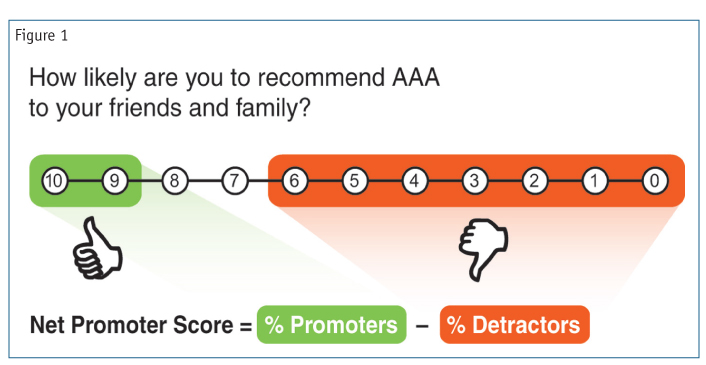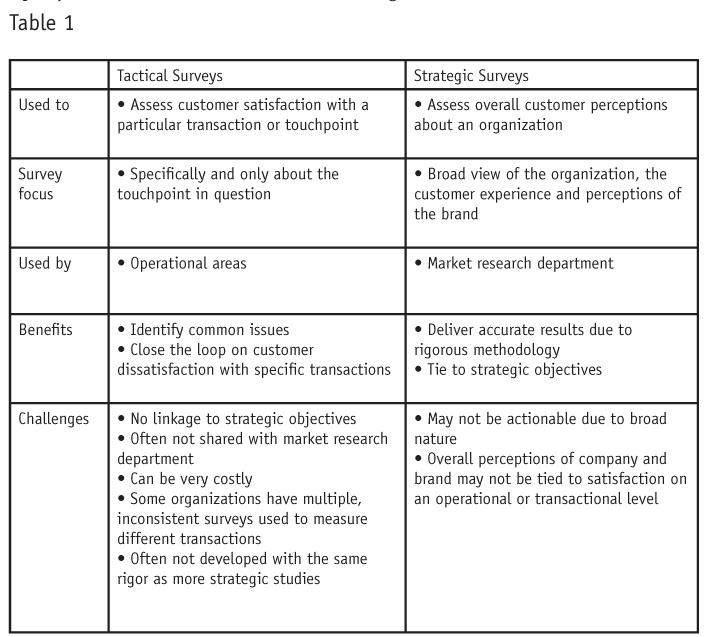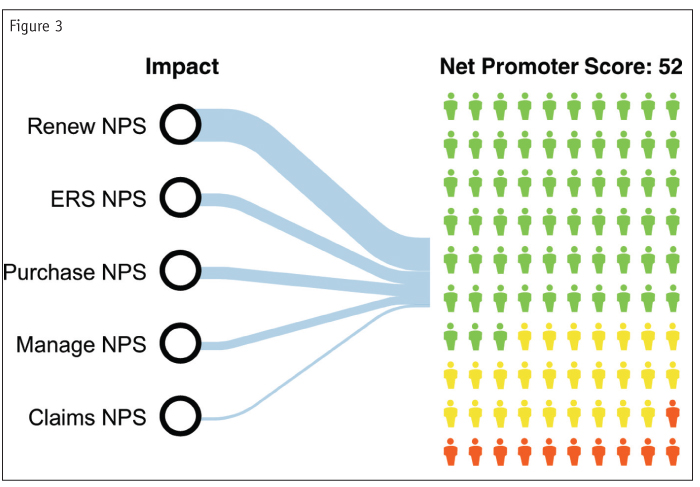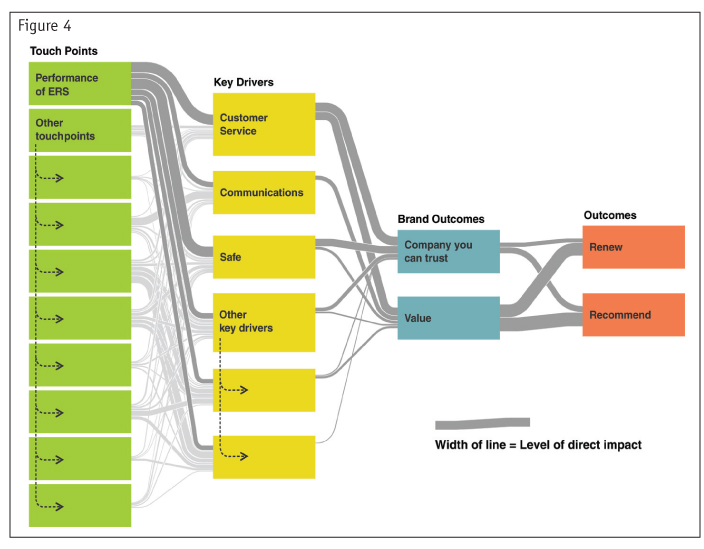Editor's note: Mark Willard is managing director at Market Strategies International, a Livonia, Mich., research firm. Mary J. Lee is the former vice president of member experience at AAA of Northern California, Nevada and Utah.
Most organizations recognize the value of measuring customer satisfaction. But many place so much emphasis on measuring the customer experience that they find themselves adrift in a sea of data gathered from multiple, disparate measurement systems. Lack of coordination creates communication issues and makes it hard to act on customer feedback.
Such was the case at AAA of Northern California, Nevada and Utah. As one of the largest AAA clubs in the country, it knows the value of gathering input from its 4.2 million members. The club used a number of surveys to obtain feedback on specific transactions and touchpoints, such as emergency roadside service, claims and the Web site. Unfortunately, the teams did not use a common metric and measurement scale and communication and coordination across the enterprise were poor. The result was an overload of data and wasted effort. The customer data were not actionable.

Working with Livonia, Mich., research firm Market Strategies, AAA put into place a common metric across all customer touchpoints. AAA decided to use Net Promoter Score (NPS), a widely-used system with the benefit of being easy to communicate throughout a large organization. The crux of NPS is one question – “How likely are you to recommend AAA to friends or family?” – based on satisfaction with a transaction. Using a consistent, 11-point scale (0 to 10), the surveys determine whether members are Promoters, Passives or Detractors (Figure 1).
Defining the customer experience can be difficult; accurately measuring it is far more challenging. Many organizations struggle with:
- applying a proven methodology to the measurement of customer satisfaction with specific transactions or touchpoints;
- closing the loop on negative customer feedback;
- modeling the impact of specific transactions on the overall customer relationship;
- linking together high-level strategic and tactical studies of customer satisfaction;
- coordinating efforts between various departments (e.g., market research, operational areas) tasked with customer experience research;
- bridging the gap between various measurement systems already in place; and
- quantifying the link between key drivers of satisfaction and desired business outcomes, e.g., increases in sales, customer retention and likelihood to recommend the organization.
And of course, just understanding how customers rate their experience is not enough; AAA needed to act on member feedback to turn members into Promoters but it had no reliable way to do so. The system developed with Market Strategies gave it a measurable, actionable way to turn dissatisfied customers into evangelists by empowering AAA employees to quickly close the loop with Detractors, one member at a time. An online portal flags members who rate as Detractors due to their recent experience. The system then generates an e-mail to the appropriate management-level AAA employee, requesting action within a specific time period.
Equally effective
While AAA created a series of cohesive, transactional surveys around an NPS measurement system, other metrics are equally effective. A flexible and customized approach to customer experience measurement allows a system to be built around a metric already in place at an organization. Customer satisfaction, customer effort (the measure of how much effort a customer puts into the relationship with a company) and loyalty are just a few examples.
Regardless of the metric, it must be used consistently across all customer touchpoints and transactions. Companies that take a uniform approach find it is more easily understood by employees, which simplifies communication and training. Organizations recognize cost savings through coordinating efforts and focusing on a common approach, rather than through building multiple systems from the ground up. More importantly, a consistent metric can be more easily integrated into an organization’s culture and become a basis for process improvements.

Customer feedback systems can be grouped into two broad categories, as shown in Table 1. Many organizations use both but have no linkage between the tactical and strategic research. Organizations that have a purely tactical approach and only measure transactions suffer from a myopic view of the customer experience. That’s because the customer experience is not merely a sum of all customer transactions. Organizations must link tactical work to overall strategic objectives and brand outcomes. Examples:
For an automotive company, how does satisfaction with a particular repair experience drive overall satisfaction with the brand and repurchase likelihood?
For a cable company, how does a customer’s experience with a call center affect likelihood to renew the service?
For AAA, what is the impact on the overall member experience of an extended wait time on the phone during a roadside emergency?
Impact modeling
At the heart of the integrated strategic/tactical approach is impact modeling, which measures the impact of each transaction on key drivers of satisfaction (e.g., customer service, communications, price) with the overall customer experience. Going further, the model assesses how satisfaction with a key driver influences desired brand and business outcomes. In this way, a company can map the impact of a transaction, e.g., a purchase, all the way to a key strategic objective, e.g., a customer’s likelihood to recommend the organization to others. Figure 2 provides a high-level overview of the components of the impact modeling system.

To meet a company’s specific needs, an impact model can be built around whatever end objectives are most important to the business, e.g., overall satisfaction, NPS, likelihood to renew, likelihood to buy again, brand loyalty and customer effort. Recognizing that different departments might have different areas of focus, the model can integrate various end business outcomes.
The value of impact modeling is that it helps an organization determine where to focus its efforts to get the greatest return on investment. Transactions or touchpoints with a high impact on the overall customer experience deserve more attention and resources than those that don’t matter as much. Precise data about the role of each facet of the customer experience help business leaders make better decisions for the overall good of the organization.
Unlike other approaches to customer experience measurement, impact modeling is a living model. Organizations can clearly see if an improvement at a particular touchpoint would positively impact key drivers, and, in turn, the overall member experience and desired outcomes. Armed with these data, organizations can build training programs and communication strategies to help employees focus on areas of maximum importance.
Business leaders can quickly understand the value of impact modeling when they see the link between high-level strategic goals to tactical actions (and vice versa). It’s important to note that this structural equation produces results that are significantly more stable and precise than those provided through standard statistical techniques such as multiple regression.
Determine the impact
With a goal of creating member advocates, AAA pays close attention to “likelihood to recommend” as measured by NPS. As shown in Figure 3, as part of the impact modeling process, the auto club branch is able to determine the impact of different types of transactions and touchpoints, e.g., emergency roadside service (ERS) and claims on its overall NPS. One of the surprising results was that member satisfaction with the claims process had a much lower impact on the overall member experience than expected, meaning that the club could focus more on improvements in other areas.

Being able to quantify the impact of specific transactions on NPS was a great first step for AAA. But the club wanted to measure the member relationship more broadly. So, Market Strategies built a comprehensive impact model that measured the overall member experience from specific transactions through desired brand outcomes and ultimately, the desired business outcomes of “likelihood to renew” and “likelihood to recommend.”
A strength of impact modeling is its predictive nature, which makes the data actionable. In the AAA example (Figure 4), the model predicts that improvement in member perception of emergency roadside service directly impacts each of the six key drivers of the member experience.

Hypothetically, a five-point increase in the ERS score would result in a two-point increase in the key driver of customer service. The model also quantifies the increases in AAA’s desired brand outcomes of ensuring that AAA is a trusted company and that it provides value. Finally, the model demonstrates that likelihood to renew and likelihood to recommend – AAA’s two key outcomes – would both improve. In this hypothetical example, a five-point increase in the ERS score would move the needle one point on likelihood to renew.
As in any business, it is more cost-effective to retain than to attract new members. And, attracting new members through the recommendation of a member is the most cost-effective form of customer acquisition. Therefore, AAA realizes significant ROI from increases in both of its desired outcomes.
Comprehensive plan
Customer-centricity is an admirable goal and one that many companies strive for. But it’s only achievable when it becomes part of an organization’s culture. An initial step is a comprehensive plan to communicate what defines the customer experience and how it is being measured. Maintaining momentum requires training for individual employees and teams on how they can positively impact the customer experience.
An online portal, delivering up-to-date customer feedback and concise summary reporting, is essential in integrating customer experience measurement into the organization. Employees can model the impact of improvements in customer experience scores with a particular touchpoint or transaction on key drivers and, in turn, strategic business outcomes. This information can be used in goal-setting for both individuals and teams. In AAA’s case, its portal is widely used by employees up to the CMO and CFO for planning purposes. Some organizations also utilize the results of customer experience measurement as a component in incentive pay to drive home its importance. AAA successfully uses this approach.
Benefits are multifaceted
The benefits of quantifying the link between discrete customer touchpoints and overall desired business outcomes are multifaceted. Organizations such as AAA that successfully integrate a combined strategic/tactical approach to measuring the customer experience into their culture realize many benefits, including: alignment between tactics and strategy – from individual customer transactions and touchpoints up to high-level corporate objectives; employee understanding of how their actions impact the customer experience; better coordination and resource management between operational and market research departments tasked with measuring and managing the customer experience; ability to track and communicate performance across the enterprise; actionable feedback to improve the customer experience and “close the loop” on negative experiences of individual customers; and, perhaps most important, bottom-line improvements in areas that matter most to the business.
